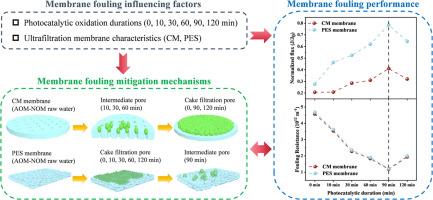藻类和天然有机物诱导的超滤膜污染缓解机制:光催化预氧化度和膜性能的依赖
IF 12.4
1区 环境科学与生态学
Q1 ENGINEERING, ENVIRONMENTAL
引用次数: 0
摘要
藻类和天然有机物(AOM-NOM)诱导的超滤膜污染是饮用水处理中的一个难题。采用粉末活性炭负载的Bi2O3-TiO2/PAC(双掺杂TiO2纳米复合材料)光催化UF对AOM-NOM的去除效果进行了评价,并阐明了该工艺对陶瓷膜和聚醚砜膜的污染缓解效果和机理。陶瓷膜对AOM-NOM去除和膜污染的最佳光催化时间为90 min。陶瓷膜对溶解有机碳(DOC)的去除率为65.78%,对UV254的去除率为96.06%,对荧光组分的去除率为97.46%,对组分1和2的去除率为96.71%。该工艺提高了除低分子量中性有机物外的AOM-NOM馏分的去除率。聚醚砜膜在光催化作用下表现出较低的膜污染,而在AOM-NOM中观察到的可逆污染主要归因于蛋白质样物质。适度的光催化诱导特异性阻断模型抑制饼层的形成。此外,AOM-NOM的去除降低了膜与污染物之间的粘附自由能。陶瓷膜和聚醚砜膜的总界面自由能绝对值分别从64.13和53.24 mJ/m2降至35.14和17.66 mJ/m2。这些机制协同降低了膜污染倾向。本研究为光催化-超滤工艺在含藻水深度处理中的应用提供了技术支持。本文章由计算机程序翻译,如有差异,请以英文原文为准。


Ultrafiltration membrane fouling mitigation mechanism induced by algal and natural organic matters: Dependence of photocatalysis pre-oxidation degree and membrane properties
Ultrafiltration (UF) membrane fouling induced by algal and natural organic matters (AOM-NOM) is a challenging issue in drinking water treatment. AOM-NOM removal was evaluated using a process combining Bi2O3-TiO2/PAC (Bi-doped TiO2 nano-composites supported by powdered activated carbon) photocatalysis with UF, and fouling mitigation effectiveness and mechanisms of the process for ceramic and polyethersulfone membranes were elucidated. The optimal photocatalytic duration for AOM-NOM removal and membrane fouling mitigation was 90 min. Ceramic membranes exhibited superior performance in dissolved organic carbon (DOC) (65.78 %), UV254 (96.06 %) and fluorescent components removal (97.46 % and 96.71 % for components 1 and 2). The process enhanced AOM-NOM fractions’ removals except for low-molecular-weight neutral organics. Polyethersulfone membranes demonstrated a pronounced lower membrane fouling by photocatalysis, and the reversible fouling observed in AOM-NOM was primarily attributed to protein-like substances. Moderate photocatalysis induced specific blocking models that inhibited cake layer formation. Moreover, AOM-NOM removal reduced the adhesion free energy between membranes and foulants. The absolute values of total interfacial free energy decreased from 64.13 and 53.24 mJ/m2 to 35.14 and 17.66 mJ/m2 for ceramic and polyethersulfone membranes, respectively. These mechanisms synergistically attenuated membrane fouling propensity. This study provides technical support for applications of photocatalysis-UF process in advanced treatment of algae-laden water.
求助全文
通过发布文献求助,成功后即可免费获取论文全文。
去求助
来源期刊

Water Research
环境科学-工程:环境
CiteScore
20.80
自引率
9.40%
发文量
1307
审稿时长
38 days
期刊介绍:
Water Research, along with its open access companion journal Water Research X, serves as a platform for publishing original research papers covering various aspects of the science and technology related to the anthropogenic water cycle, water quality, and its management worldwide. The audience targeted by the journal comprises biologists, chemical engineers, chemists, civil engineers, environmental engineers, limnologists, and microbiologists. The scope of the journal include:
•Treatment processes for water and wastewaters (municipal, agricultural, industrial, and on-site treatment), including resource recovery and residuals management;
•Urban hydrology including sewer systems, stormwater management, and green infrastructure;
•Drinking water treatment and distribution;
•Potable and non-potable water reuse;
•Sanitation, public health, and risk assessment;
•Anaerobic digestion, solid and hazardous waste management, including source characterization and the effects and control of leachates and gaseous emissions;
•Contaminants (chemical, microbial, anthropogenic particles such as nanoparticles or microplastics) and related water quality sensing, monitoring, fate, and assessment;
•Anthropogenic impacts on inland, tidal, coastal and urban waters, focusing on surface and ground waters, and point and non-point sources of pollution;
•Environmental restoration, linked to surface water, groundwater and groundwater remediation;
•Analysis of the interfaces between sediments and water, and between water and atmosphere, focusing specifically on anthropogenic impacts;
•Mathematical modelling, systems analysis, machine learning, and beneficial use of big data related to the anthropogenic water cycle;
•Socio-economic, policy, and regulations studies.
 求助内容:
求助内容: 应助结果提醒方式:
应助结果提醒方式:


